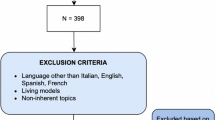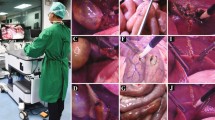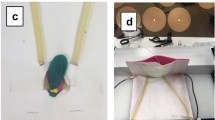Abstract
Live animal surgery still represents the best training models compared with other models due to technical limitation, which can provide full capability of encompassing all the aspects of a real surgical experience. In this chapter, tips and tricks for the organization of animal lab are detailed. And guidelines of partial nephrectomy and pyeloplasty are well described.
Access this chapter
Tax calculation will be finalised at checkout
Purchases are for personal use only
Similar content being viewed by others
References
Ramirez-Backhaus M, Hellawell G, Melo M, et al. Teaching laparoscopy to residents: how can we select good candidates? Curr Urol Rep. 2009;10:106–11.
Fearn SJ, Burke K, Hartley DE, et al. A laparoscopic access technique for endovascular procedures: surgeon training in an animal model. J Endovasc Ther. 2006;13:350–6.
Kirlum HJ, Heinrich M, Tillo N, et al. Advanced paediatric laparoscopic surgery: repetitive training in a rabbit model provides superior skills for live operations. Eur J Pediatr Surg. 2005;15:149–52.
Mori T, Hatano N, Maruyama S, et al. Significance of “hands-on training” in laparoscopic surgery. Surg Endosc. 1998;12:256–60.
Böhm B, Milsom JW. Animal models as educational tools in laparoscopic colorectal surgery. Surg Endosc. 1994;8:707–13.
Byrne P. Teaching laparoscopic surgery. Practice on live animals is illegal. BMJ. 1994;308:1435.
Wolfe BM, Szabo Z, Moran ME, et al. Training for minimally invasive surgery. Need for surgical skills. Surg Endosc. 1993;7:93–5.
Author information
Authors and Affiliations
Corresponding author
Editor information
Editors and Affiliations
Rights and permissions
Copyright information
© 2012 Springer-Verlag London
About this chapter
Cite this chapter
Sun, Y.H., Wu, Z., Yang, B. (2012). The Laparoscopic Animal Lab Training Module. In: Sun, Y., Smith, A., Yang, B. (eds) The Training Courses of Urological Laparoscopy. Springer, London. https://doi.org/10.1007/978-1-4471-2723-9_5
Download citation
DOI: https://doi.org/10.1007/978-1-4471-2723-9_5
Published:
Publisher Name: Springer, London
Print ISBN: 978-1-4471-2722-2
Online ISBN: 978-1-4471-2723-9
eBook Packages: MedicineMedicine (R0)




